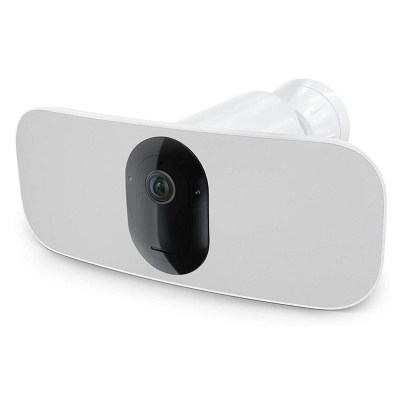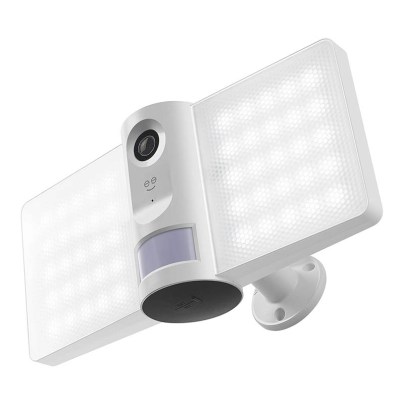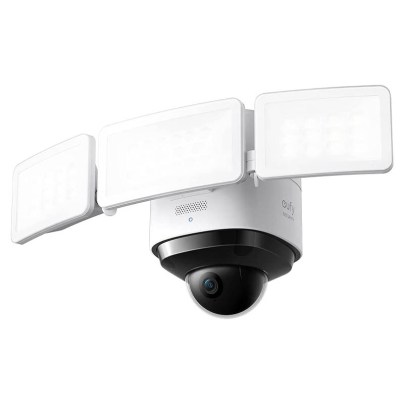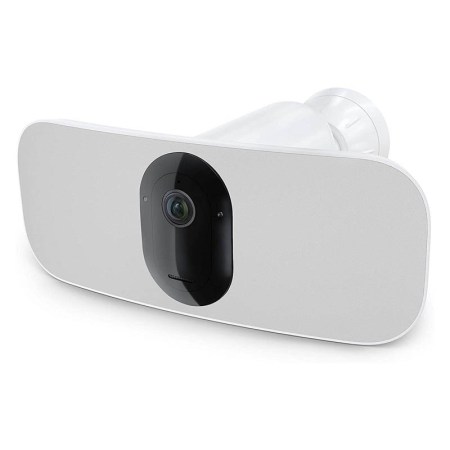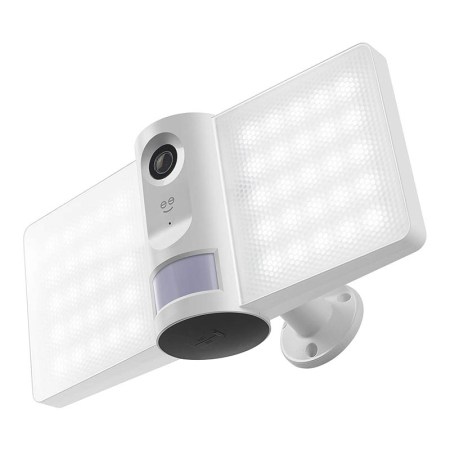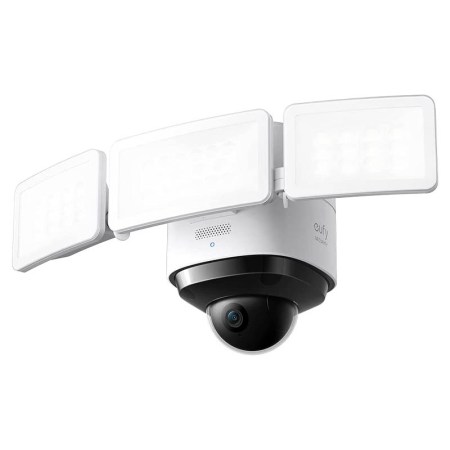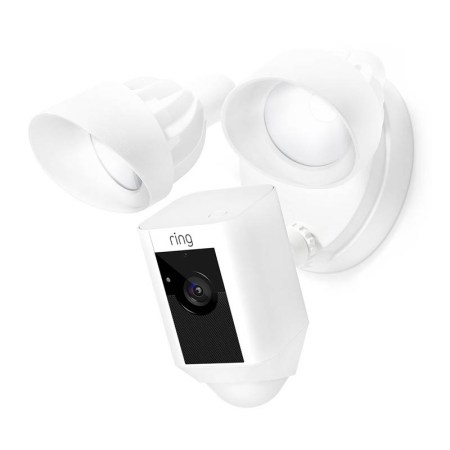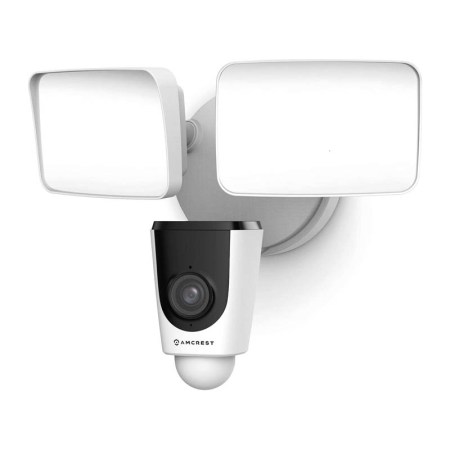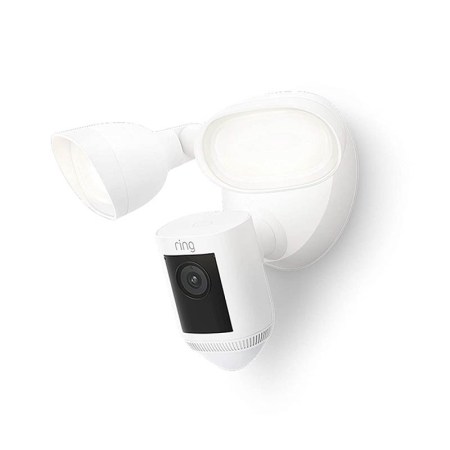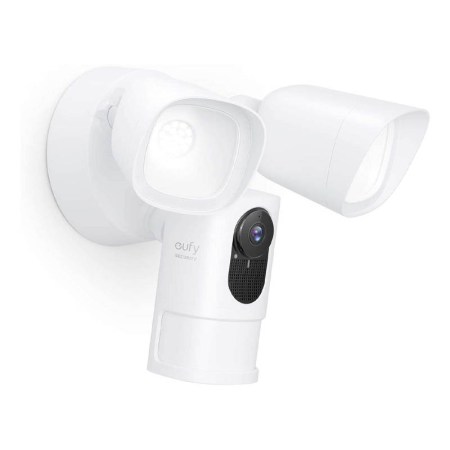We may earn revenue from the products available on this page and participate in affiliate programs. Learn More ›
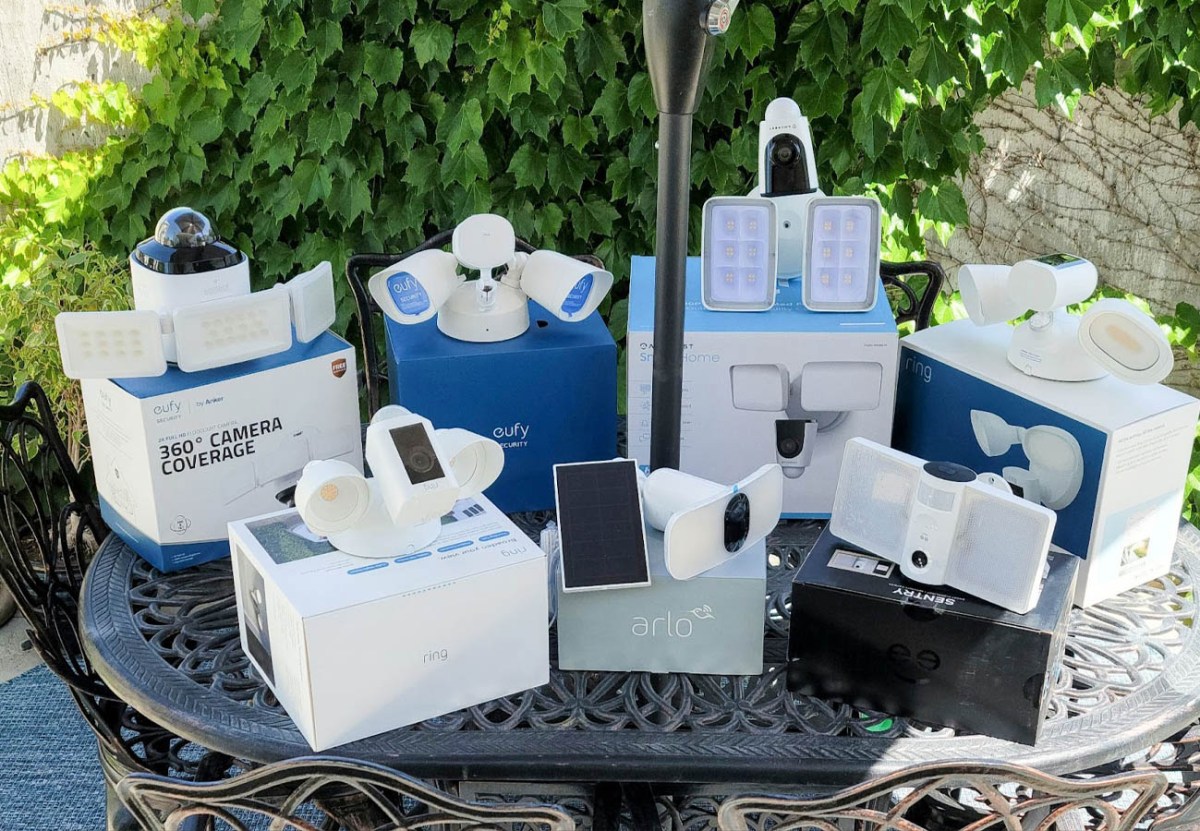
If you frequently hear car alarms sounding off at night in your neighborhood, it might be time for a floodlight camera. These devices feature a high-resolution camera with horizontal viewing angles up to 140 degrees. Some have the ability to produce 2500 lumens of light or more while recording events in the immediate area.
We wanted to see how easy it was to install a floodlight camera and how much peace of mind it offered, so we tested today’s top models. We installed the devices and then synced them with our Wi-Fi network so we could determine how well their various functions performed. Most of the models we tested had to be hardwired to an existing light box, but one was powered by a small solar panel.
Once we installed the cameras, we were able to use our smart devices to view activity outdoors in real time and to record movements and events. Ahead, learn what to look for when shopping for the best floodlight camera, and find out why the following models earned a spot on this lineup.
- BEST OVERALL: Arlo Pro 3 Floodlight Camera
- BEST BANG FOR THE BUCK: Geeni Sentry Smart Wi-Fi Floodlight Camera
- UPGRADE PICK: Eufy Floodlight Cam 2 Pro
- BEST DUAL LIGHT: Ring Floodlight Cam Wired Plus
- BEST WITH SIREN: Amcrest SmartHome 1080p Wi-Fi Outdoor Security Camera
- BEST VIEW FEATURES: Ring Floodlight Cam Wired Pro
- ALSO CONSIDER: Eufy Floodlight Camera 1080p
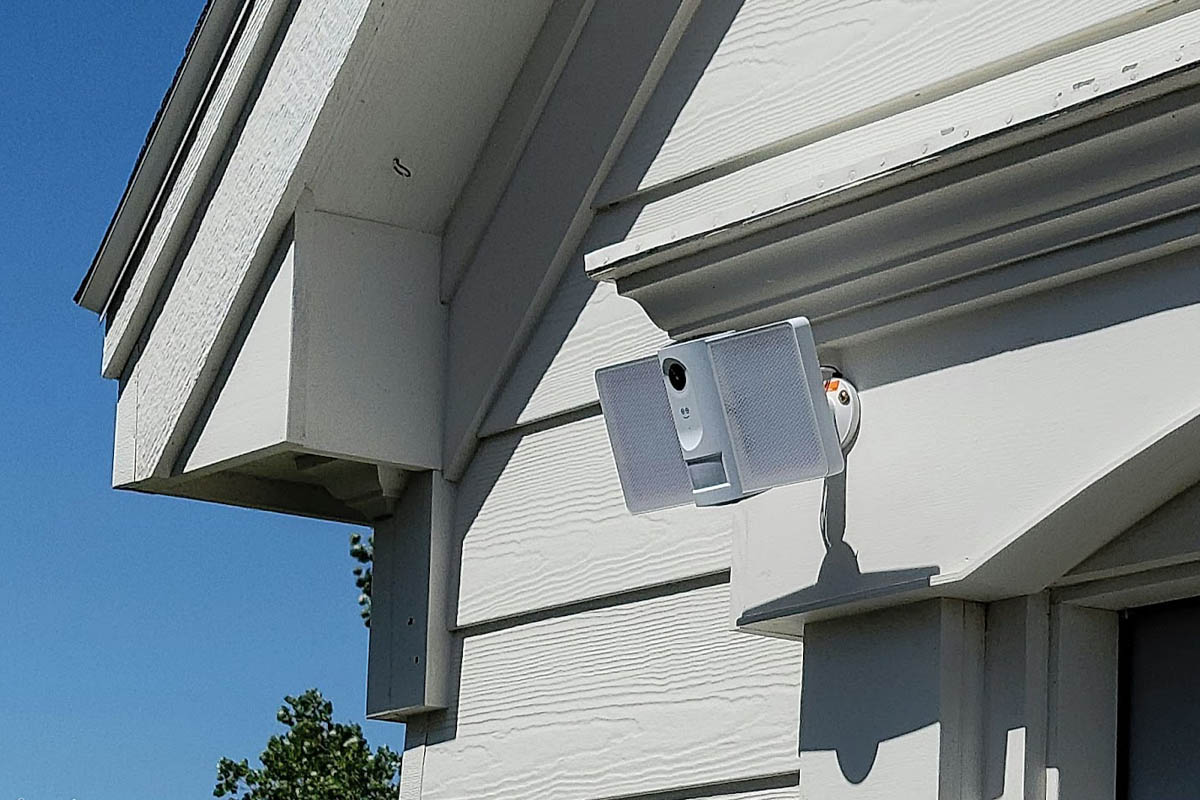
How We Tested the Best Floodlight Cameras
We wanted to know just how beneficial floodlight cameras were, so we tested some of the highest-rated models available today. To do so effectively, we installed them in suitable areas, which required hardwiring for all but one solar model. We did this using wiring already in place for existing porch lights and floodlights.
We downloaded the relevant app for each camera and followed the steps to sync the camera with our Wi-Fi network. We then used the apps to configure the cameras’ functions and view live shots of the areas. After dark, we approached the cameras to see how close we could get before triggering the motion-detection sensors. We also measured the distance of the light each floodlight cast and we noted the range of camera view.
When possible, we uploaded the videos to the company’s Cloud storage and synced the cameras to our Echo Show, where we could see a live view via the Show’s display screen. We inspected the video images for clarity and facial recognition, which was good across the whole range of cameras. We tested the sirens and figured out which ones were the loudest (just by ear). We used the two-way audio features and paid attention to how clear voices sounded and whether the microphone picked up background noise.
Over the course of 3 weeks, we continued testing, using our smart devices to monitor the live view. During that time, we sprayed the cameras with a light mist from the garden hose to see whether the casing was waterproof. All cameras came through that test with flying colors.
We used a rubric and awarded points for each test. At the end of the testing, we added the points and used them to help identify the award categories for each floodlight camera.
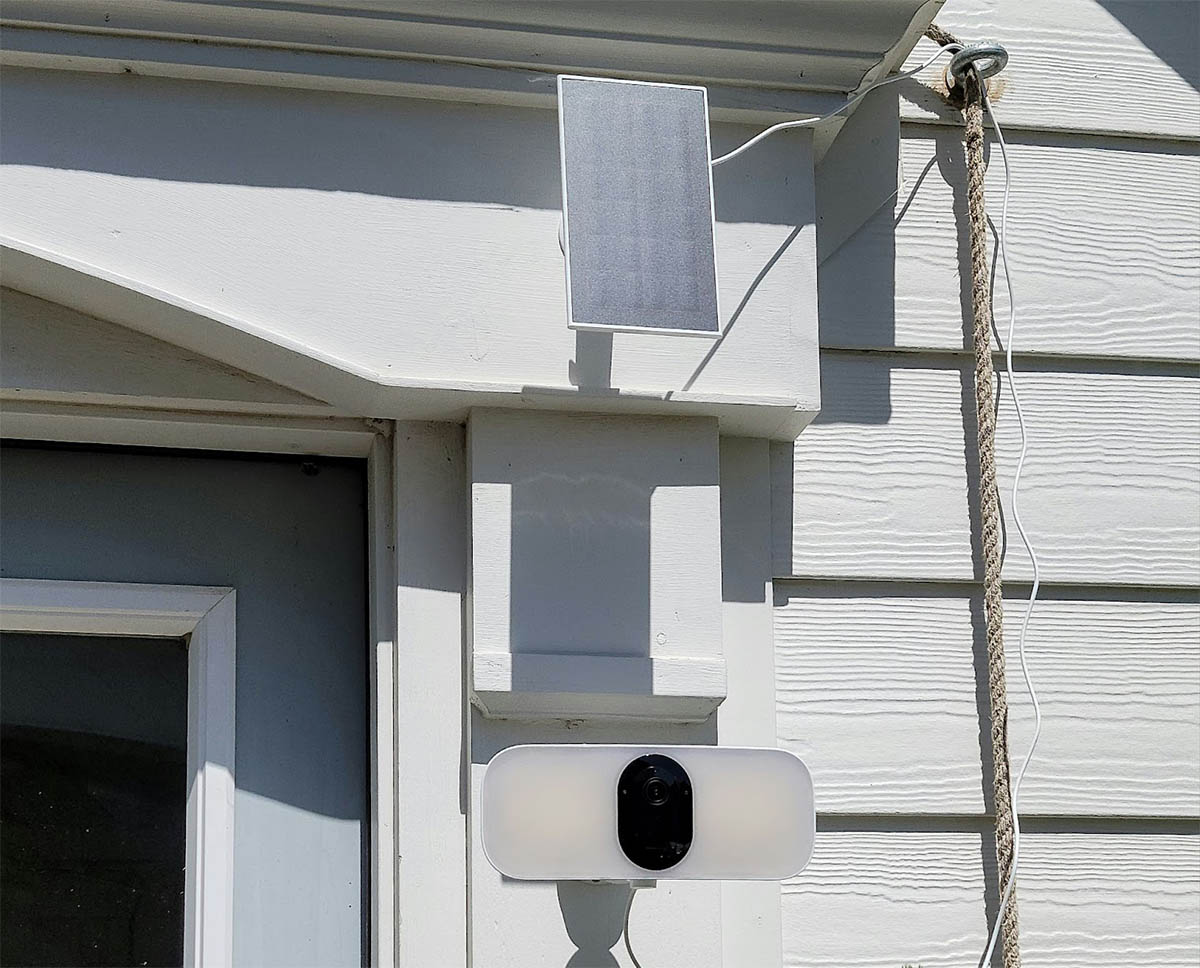
Our Top Picks
For a floodlight camera to earn a spot on this lineup, it had to come with at least 1080p resolution. We felt lower-resolution cameras didn’t provide enough clarity for security purposes. In addition, we only tested devices with floodlights brighter than 1800 lumens. Some models had additional features such as infrared night vision, sirens, and two-way communication. We tried every function to determine the versatility of each camera. The following cameras took top honors in our hands-on tests.
Best Overall
Arlo Pro 3 Floodlight Camera
See ItFor clear images, ample lumens, and helpful extras without hardwiring, the Arlo Pro 3 is an excellent all-around floodlight camera. To get started, we downloaded the Arlo app (the unit doesn’t come with printed installation instructions in the box), which worked without a hitch and walked us through the setup with concise, easy-to-follow directions. We installed the Pro 3 beside an exterior door and attached the Arlo Solar Panel to charge its battery (sold separately). Alternatively, users can charge the battery by plugging its power cord into a standard power outlet. We configured the Pro 3 from our smartphone and synced it to our Echo Show. By issuing the voice command, “Alexa, show the courtyard camera,” we could see the area clearly on the Show’s screen; we could even zoom in for a closer look.
We were impressed with Arlo’s exceptional clarity, thanks to a 2K camera with high-definition resolution (HDR) that creates an ultraclear color picture, even in dark conditions. The floodlight is bright, too, with a 2000-lumen output.
The motion detector on the Pro 3 triggered the floodlights and started recording in 1-minute increments. The camera captures a 160-degree range of view, and we found images on both the daylight and nighttime videos clear and well defined. The camera’s two-way audio allowed us to talk back and forth, but on a windy day, the sound was slightly distorted
The Arlo Pro 3 also has an optional siren, which is quite loud. We were able to trigger the siren from the app, and we could also configure it to go off when motion was detected. The only downside we noticed was that the rechargeable battery in the Arlo Pro 3 ran down quickly after a few cloudy days when the solar panel wasn’t fully charging it. However, this could be remedied simply by running its cord to an outlet. We took advantage of Arlo’s free 3-month trial Cloud storage to upload and view our videos.
Product Specs
- Camera resolution: Up to 2K
- Lumens: 2000 lumens
- Camera field of view: 160 degrees
Pros
- High-resolution camera; HDR quality for identifying visitors
- Siren included in construction in case of intruders or unexpected visitors
- 2-way audio for ease of communication
- Infrared night vision for high visibility
Cons
- Requires the purchase of solar panel for remote charging
- 2-way audio distorted in windy conditions
- After 3 months, users must pay for Cloud storage
Get the Arlo floodlight camera at Amazon or Best Buy.
Best Bang for the Buck
Geeni Sentry Smart Wi-Fi Floodlight Camera
See ItHome security needn’t come at a high price with the Geeni Sentry Floodlight Camera, which offers some of the same impressive features of pricier brands at an affordable cost. The Geeni requires hardwiring, so we connected it to an existing exterior light box and then downloaded the Geeni app, which gave us easy-to-understand instructions for configuring the camera and syncing it to our Alexa Show. Geeni doesn’t offer a free Cloud storage trial, but an SD card port located on the back of the device offers an alternate method of video storage. We slipped an 8-gigabyte (GB) SD card into the slot and started testing.
We approached the Geeni, which detected our movement at a distance of about 16 feet, triggering the floodlights and the camera’s recording. More motion-detection range would have been nice, but the 2100-lumen floodlights were bright enough to startle an intruder. The camera has a 140-degree view range, which is sufficient for seeing a good portion of a small yard or entry, and the 1080p video resolution was clear—we could easily see facial features.
A minor downside was the high sensitivity of the motion detector. It triggered the lights and camera (and siren, when enabled) when something as small as a hummingbird flew past. The siren is very loud, so we opted to engage it only manually from our smartphone to avoid false alerts.
After testing the camera for 3 weeks, we removed the SD card and checked the videos. Unfortunately, our 8GB SD card had run out of memory, so it didn’t record the last few videos. We suggest using an SD card with more memory for users who want to capture videos without paying a Cloud-storage subscription fee. That issue aside, we found the Geeni to be a robust floodlight camera that affords home security at an attractive price point.
Product Specs
- Camera resolution: 1080p
- Lumens: 2100 lumens
- Camera field of view: 140 degrees
Pros
- High lumen output; 2100 lumens of light for ample visibility
- Includes security siren in the event of intruders or unexpected visitors
- Can record to SD card for storing footage
Cons
- Not as durable as higher-priced cameras
- Motion detection may be too sensitive
- Must be hardwired to operate correctly
Get the Geeni floodlight camera at Amazon or The Home Depot.
Upgrade Pick
Eufy Floodlight Cam 2 Pro
See ItWhile most security cameras are limited to pointing in a single direction, the Eufy Floodlight Cam 2 Pro can rotate 360 degrees and tilt as well, allowing the user to track visitor or trespasser movement through the property. It uses artificial-intelligence technology and advanced motion detection to lock onto a moving subject automatically and follow the individual through the coverage area.
This floodlight camera looked impressive out of the box, and we opted to install it on the underside of our covered patio ceiling where it could monitor the comings and goings of visitors to our back door. This is another hardwired model, so it should be installed in the place of an existing exterior light. At 3000 lumens, this is the brightest of all the camera lights we tested. When triggered, it lit up the entire 15-foot-by-15-foot patio, plus about 10 feet beyond it.
We’d already installed the Eufy app for another model, and it quickly detected this camera. We were able to configure the light’s intensity, video recording duration, and motion-detection sensitivity from the app. The camera provides 8GB of internal storage and offers a subscription Cloud storage plan. The 2K camera resolution was clear and we could easily identify facial features. Unfortunately, motion detection does not trigger the camera or lights until a person gets about 18 feet away.
The big difference between this floodlight camera and others we tested was the ability to pan the camera angle from our smartphone to see in different directions. This gave us a 360-degree range of view, which was pretty impressive. This Eufy model doesn’t come with two-way audio or a siren, but it’s a top pick for those who want high-resolution videos, tracking ability, and bright illumination.
Product Specs
- Camera resolution: 2K
- Lumens: 3000 lumens
- Camera field of view: 360 degrees
Pros
- Camera can tilt and pan 360 degrees for excellent security and visibility
- Camera will lock onto a subject automatically in case of intruders
- 3 powerful LED floodlights produce 3000 lumens of light
- Pets did not trigger the lights or camera; only detects real threats
Cons
- No siren integrated into the machine; may not be ideal for some users’ preferences
Get the Eufy floodlight camera 1080p at Best Buy or Newegg.
Best Dual Light
Ring Floodlight Cam Wired Plus
See ItThis Ring floodlight camera comes with two adjustable lamps that we configured to reach where we wanted the most illumination. While these are fairly bright floodlights—the two together produce 2000 lumens, and each throws bright light to a distance of about 20 feet—we found the motion-detection range to be on the short side, about 13 feet away from the device.
Setup was quick and easy through the Ring app, although we still had to hardwire the camera using the wires from an existing light. We could sync the camera to our Wi-Fi and Echo Show, allowing us to view live streaming video on the Echo Show display screen. Ring offers a free 30-day Cloud storage trial so that we could upload and store our test videos online.
The Ring floodlight camera has a view zone of 140 degrees, and its 1080p resolution offers ample clarity—we could identify facial features, even on the nighttime recordings. We were able to configure the motion sensitivity to pick up only humans and not pets or birds, which was a nice feature.
We were able to receive notifications on our smartphone when motion triggered the camera, and the Ring features two-way audio that transmits voices clearly. The siren, which can be triggered by motion or manually from a smartphone, was quite loud and seemed adequate to startle an intruder.
Product Specs
- Camera resolution: 1080p
- Lumens: 2000 lumens
- Camera field of view: 140 degrees
Pros
- Syncs with Echo Show and Alexa for monitoring and adjusting
- In-color night images for ample visibility and security
- Clear and audible 2-way talking for ease of communication
- Integrated siren to alert homeowners of threats or unexpected visitors
Cons
- Shallow motion-detection range may not meet the needs of some users
Get the Ring Wired Plus floodlight camera at Amazon, Lowe’s, or Best Buy.
Best with Siren
Amcrest SmartHome 1080p Wi-Fi Outdoor Security Camera
See ItIf the sudden illumination of a bright floodlight isn’t enough to deter trespassers, a seriously loud siren might just do the trick. This floodlight camera from Amcrest blasts would-be bad guys with a 110-dB motion-activated siren. While some of the other floodlight cameras we tested also came with sirens, this Amcrest model was by far the loudest, and we felt it offered the best shot at scaring away a ne’er-do-well.
We downloaded the Amcrest app, which walked us through the syncing and configuration steps. The camera features 1080p resolution with a 114-degree range of view, which we considered too narrow a field to offer a whole lot of security. But those only looking to monitor a limited area, such as a corridor, would likely find it more than suitable. The two adjustable floodlights provide 2000 lumens, and each one casts light about 25 feet away.
The motion-detection range is decent—we could get about 22 feet from the camera before it triggered the lights and started recording. The camera doesn’t offer advanced security features, such as the ability to dim lights or adjust the motion sensitivity. Still, it provides good clarity and one heck of a loud siren. The siren can be set to go off with motion or be engaged from a smartphone. Unfortunately, the two-way talk feature picked up background noise, making it difficult to hear the voices.
The camera can store footage on an SD card or Amcrest’s Cloud-based subscription service. We took advantage of Amcrest’s 1-month trial storage, but we felt that using an SD card with ample memory would probably be a good alternative.
Product Specs
- Camera resolution: 1080p
- Lumens: 2000 lumens
- Camera field of view: 114 degrees
Pros
- Bright flood lights integrated; produces 2000 lumens of light
- Loud 110-dB siren alerts homeowners of threats or unexpected visitors
- Free trial Cloud storage included with purchase
Cons
- Narrow field of vision compared to other floodlight cameras available
- Slightly challenging to hear on 2-way audio
Get the Amcrest floodlight camera at Amazon.
Best View Features
Ring Floodlight Cam Wired Pro
See ItThose hoping to add the ultimate in high-tech security monitoring need look no further than the Ring Floodlight Cam Wired Pro. This Ring camera is a step up in technology, and it offers advanced security features that seem straight out of a spy thriller. Its basic functions are all top-notch, too. It records in 1080p resolution and features two adjustable lamps that emit 2000 lumens of light. We installed the Ring Pro on a barn where we’d previously had some problems with theft. We were able to adjust the two lamps to illuminate certain areas.
The motion-detection range on this Ring is good—we couldn’t get any closer than 25 feet without triggering the lights and camera. Each of the lamps cast light up to nearly 30 feet, and we were able to configure both the light and recording duration from our smartphone. The two-way audio is clear and voices were easy to understand. The siren, which can be configured to go off when motion is detected or turned on remotely, is startlingly loud.
It takes a little while to get used to the bird’s-eye view function, but we liked it once we figured it out. This feature syncs with satellites in real time to monitor the movements of someone on the property. The bird’s-eye view appears as a pop-up window, and rather than showing a human being walking around, it leaves dots on an aerial shot of the home. As the person moves, new dots appear and track the person’s path.
We eventually figured out that the dots are color-coded, turning from white to yellow to red and finally fading away. Every time a white dot appears, it indicates the person just moved. It’s a neat idea and offers the ability to see how the person has moved around the property. Once the person moves outside a range of about 30 feet from the device, the dots no longer appear.
The downside is that the bird’s-eye pop-up window blocks some of the view of the main video screen, which can be distracting. However, the bird’s-eye pop-up can be disabled to view the entire main video and re-enabled when desired.
The motion sensitivity on this Ring was excellent. It never triggered due to pets or animals (it was installed in an area where we see a lot of deer), so we were spared false notifications. It comes with a 30-day Cloud storage trial.
Product Specs
- Camera resolution: 1080p
- Lumens: 2000 lumens
- Camera field of view: 140 degrees
Pros
- Bird’s-eye view camera for ample visibility
- Siren and 2-way talk features allow homeowners to communicate with wanted or unwanted visitors
- Clear images and video; provides 1080p clarity
Cons
- Bird’s-eye pop-up blocks part of the camera display
- Must be hardwired; may require some professional help to install
Get the Ring Wired Pro floodlight camera at Amazon or Ring.
Also Consider
Eufy Floodlight Camera 1080p
See ItWhile most security cameras are limited to pointing in a single direction, the Eufy Floodlight Cam 2 Pro can rotate 360 degrees and tilt as well, allowing the user to track visitor or trespasser movement through the property. It uses artificial-intelligence technology and advanced motion detection to lock onto a moving subject automatically and follow the individual through the coverage area.
This floodlight camera looked impressive out of the box, and we opted to install it on the underside of our covered patio ceiling where it could monitor the comings and goings of visitors to our back door. This is another hardwired model, so it should be installed in the place of an existing exterior light. At 3000 lumens, this is the brightest of all the camera lights we tested. When triggered, it lit up the entire 15-foot-by-15-foot patio, plus about 10 feet beyond it.
We’d already installed the Eufy app for another model, and it quickly detected this camera. We were able to configure the light’s intensity, video recording duration, and motion-detection sensitivity from the app. The camera provides 8GB of internal storage and offers a subscription Cloud storage plan. The 2K camera resolution was clear and we could easily identify facial features. Unfortunately, motion detection does not trigger the camera or lights until a person gets about 18 feet away.
The big difference between this floodlight camera and others we tested was the ability to pan the camera angle from our smartphone to see in different directions. This gave us a 360-degree range of view, which was pretty impressive. This Eufy model doesn’t come with two-way audio or a siren, but it’s a top pick for those who want high-resolution videos, tracking ability, and bright illumination.
Product Specs
- Camera resolution: 2K
- Lumens: 3000 lumens
- Camera field of view: 360 degrees
Pros
- Camera can tilt and pan 360 degrees for ample security and visibility
- Camera will lock onto a subject automatically
- 3 powerful LED floodlights produce 3000 lumens
- Pets didn’t trigger the lights or camera
Cons
- No siren integrated; may not be ideal for some users’ preferences
Get the Eufy floodlight cam 2 Pro at Amazon, Best Buy, or Newegg.
Jump to Our Top Picks
What to Consider When Choosing the Best Floodlight Camera
The resolution of the camera, which is crucial for picture clarity, and the brightness of the floodlight are among the two most essential attributes to consider when selecting a floodlight camera, but there are other features to look into as well. These include the power source, motion detection range, and smart-home compatibility. Ahead, learn more about choosing the best floodlight camera for residential security.
Power Source
Floodlight cameras typically use a rechargeable battery or are hardwired to the home. This type of camera generally does not use a standard power cord that plugs into a wall outlet, although there are exceptions. Floodlight cameras with rechargeable batteries offer the convenience of easy wireless installation, but they have a limited power source.
Floodlight cameras that require hardwiring connect to a standard light fixture electrical box with one hot wire, one neutral wire, and one ground wire. Installing a floodlight camera to an existing electrical box is a task many DIYers should be able to complete in less than an hour with basic tools. To install the floodlight camera in a spot with no existing wires, an electrician will most likely need to run the new wires.
Brightness and Coverage
A floodlight camera’s ability to monitor property is determined by the brightness of its floodlights and the field of view of the camera.
To determine how much coverage a floodlight has, first look into its power output, which is measured in lumens. The greater the number of lumens, the brighter the floodlight and the better it can illuminate the area. A floodlight’s range is referred to as throw. The brighter the floodlight, the greater its throw. Most floodlight cameras have an output of around 2000 lumens, which gives the light a throw of approximately 30 feet.
In addition to the visibility afforded by the floodlights, the camera’s coverage is determined by its field of view. Usually, this ranges from 115 degrees to 140 degrees with a vertical field of view that’s around 80 degrees. The wider the field of view, the more the camera is capable of monitoring.
Resolution and Night Vision
Floodlight cameras come with video resolution options of 720p, 1080p, and 2K—numbers that refer to the horizontal line of pixels that create the image. The greater the number, the higher the resolution of the video. For floodlight cameras, resolution matters because it determines how clearly one can identify facial features and other identifying aspects. This is especially important given that these images are taken at night. High-resolution cameras create clearer images at greater distances, making detecting faces and reading license plates easier.
Some cameras feature a night-vision lens, which uses infrared light to create images. An infrared light with night vision serves as a stealthier camera, as it works without alerting visitors to its presence by turning on the floodlight.
Audio
Most cameras go beyond allowing the user to monitor who is in the area with visuals. Some have built-in, two-way microphones that allow a visitor and the user to communicate. This is handy for instructing a delivery person on where to leave a package, interacting with guests, or warning a would-be intruder that they’re on camera.
Motion Detection
Floodlight cameras operate via a motion detector to monitor activity around the home. When the device detects motion, it signals the camera to begin recording. Since these outdoor security cameras can cover a wide area (up to 140 degrees horizontally), some come with customizable settings that allow the user to specify what parts of the camera’s view should trigger the motion detector. This eliminates false alarms that may result in unnecessary footage of passersby on the sidewalk or a visit from the neighbor’s cat.
Smart-Home Compatibility
Most floodlight cameras connect to a home’s Wi-Fi network, granting access to live and archived video footage on demand from any smart device, including smartphones and voice-activated digital assistants such as Echo Show (a video device in the Alexa family of smart devices). Some models are even sold with a digital assistant viewer as a complete home security system: When the doorbell is triggered, the viewer instantly displays a live feed from the camera.
Additional Features
Several other features often accompany a floodlight camera to increase efficacy and convenience, including:
- Backup battery: Some floodlight cameras come with rechargeable backup batteries that keep them up and running in the event of a power outage. These backup batteries can last several days before needing a recharge.
- Siren: If a 2500-lumen light isn’t enough to deter unwanted visitors, a loud noise may do the trick. Many floodlight cameras have speakers that emit a siren to scare off trespassers. These sirens can be shockingly loud—up to 110 decibels (dB), which is comparable to the sound of a jet taking off. The user can manually activate the siren or set it to go off upon motion detection.
- Storage: There are two options when it comes to accessing stored video footage: local storage and cloud storage. Many manufacturers offer subscription-based services that hold archived security footage from the camera, allowing the user to access the footage on demand from Microsoft Cloud via a smartphone or a computer. Other cameras use secure digital (SD) cards that will enable the user to store video footage.
- Encryption: These cameras use a Wi-Fi signal to connect to a home’s network, which means they have the potential to be hacked—granting unauthorized access to the home’s cameras. As a precaution, most manufacturers use end-to-end encryption with its floodlight cameras, which only allows the user’s devices to access the camera and its recorded footage on Cloud storage.
Installation
Installing a floodlight camera is a job most DIYers can complete in less than an hour with a few basic tools. Installing a battery-powered unit involves mounting the camera and lights to the house with a kit.
Hardwiring involves connecting the camera floodlight to an existing light box on the home’s exterior, similar to changing out a light fixture on the home’s interior. Once installed, the floodlight camera’s app provides instructions for connecting the device to the home’s Wi-Fi network.
FAQs
Network speeds, video storage, and protection from hackers are other important factors to consider when shopping for a floodlight camera. Below are answers to questions that address these concerns.
Q. What is the difference between a spotlight camera and a floodlight camera?
Floodlight security cameras produce significantly more light than spotlight cameras, making them capable of illuminating a larger area. While a spotlight camera may produce around 300 or 400 lumens, most floodlight cameras produce around 2000 lumens.
Q. What is the ideal bandwidth for a floodlight camera?
While faster is always better, the best bandwidth for a floodlight camera is 2 megabytes (MB) of upload speed or more.
Q. Is data encrypted on a floodlight camera?
With hacking becoming a growing problem with home security cameras, more and more manufacturers are adding end-to-end encryption to their products. End-to-end encryption means a hacker cannot spy in without access to your personal device.
It’s important to note that end-to-end encryption is only available on cameras that are hardwired to the home. Battery-powered models do not have the power required for this encryption.
Q. What’s the storage capacity for a floodlight camera?
Some cameras use an SD card for video storage, which can hold 64 GB or more of data. Others may offer unlimited storage in the Cloud for a small monthly fee. Floodlight cameras create video files that are about 3.2 megabytes each, which equates to about 32 MB for 10 short videos per day.
